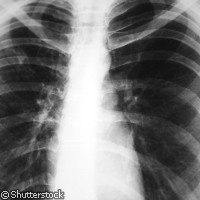Installing ultraviolet C (UVC, a type of UV ray) lights in the upper part of wards and waiting rooms could cut the spread of tuberculosis (TB) in hospitals by 70%, new international research published in the journal PLoS Medicine reveals. According to the scientists, UVC lights, combined with fans to circulate the air, offer an effective, low-cost means of reducing infections in parts of the world where more expensive infection control measures, such as negative pressure rooms, are not an option.

TB is caused by the bacterium Mycobacterium tuberculosis. When a sufferer coughs, the bacteria are released into the air in tiny droplets, where they can infect fellow patients, visitors and healthcare staff alike. In most infected people, the bacteria remain dormant and the person may never know they are infected. However, in 10% of cases, the bacteria become active, and the patient experiences the classic symptoms of TB, which include a persistent cough, fever, weight loss and night sweats. Those with immune systems weakened by HIV, for example, are particularly vulnerable to contracting TB.
'When people are crowded together in a hospital waiting room, it may take just one cough to infect several vulnerable patients,' commented Dr Rod Escombe of Imperial College London in the UK. 'Our previous research showed that opening windows in a room is a simple way to reduce the risk of tuberculosis transmission, but this is climate dependent - you can't open the windows in the intensive care ward of a Siberian hospital for example.'
Other infection control measures include negative-pressure mechanical ventilation systems, but these are expensive to install and maintain, and offer only limited protection. Laboratory evidence shows that UVC lights are able to kill TB bacteria, including drug-resistant strains, by damaging their DNA. High-intensity UVC lights are already used to disinfect ambulances and operating theatres.
However, few clinics use UVC lights in their wards and waiting rooms because there are no studies demonstrating their efficacy at reducing infection. In this latest study, the scientists installed UVC lights and negative ionisers in a hospital ward in Lima, Peru, where 69 patients with HIV and TB were undergoing treatment. For 535 consecutive days, air from the wards was pumped up to enclosures on the roof housing guinea pigs, which are extremely susceptible to TB.
The guinea pigs were divided into three groups: one was exposed to untreated air, the second was exposed to air treated with UVC lights, and the third breathed in air that had been treated with negative ionisers. The animals were tested for TB on a monthly basis and autopsied to look for signs of the disease.
By the end of the experiment, 35% of the animals in the control group had become infected with TB and 8.5% had developed the active form of the disease. In the group that breathed ionised air, 14% were infected with TB and 4.3% developed the active disease. For the UVC group, just 9.5% became infected and 3.6% developed the active disease.
In the wards below, scientists adjusted the lights for efficacy and safety: they were placed at the right height and were appropriately shaded to ensure that people below would not suffer from over-exposure to UVC light. 'The lights must be set high enough to ensure patients and health workers are not overexposed, but if the lights only treat air at that level, there will be little benefit,' explained Dr Cath Noakes of the University of Leeds in the UK. 'To be most effective, ventilation systems need to create a constant flow of treated air down to patient level and potentially infected air up towards the lights.'
Dr Noakes is now working on a set of practical guidelines for the installation of UVC infection control systems in hospitals and clinics, taking into account the need to ensure a good flow of air around the building.
The researchers emphasise that the costs of the system are relatively low; a typical UVC ceiling light costs USD 350 (EUR 270) and replacement bulbs cost USD 25 (EUR 19). The researchers are now trying to bring the cost of the system down to the USD 100 (EUR 77) mark.